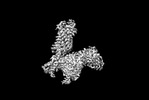登録情報 データベース : EMDB / ID : EMD-31323タイトル The structure of formyl peptide receptor 1 in complex with Gi and peptide agonist fMLF 複合体 : Complex of FPR1 with Gi and peptdie agonist fMLF複合体 : FPR1 with Giタンパク質・ペプチド : fMet-Leu-Phe receptorタンパク質・ペプチド : Guanine nucleotide-binding protein G(i) subunit alpha-1タンパク質・ペプチド : Guanine nucleotide-binding protein G(I)/G(S)/G(T) subunit beta-1タンパク質・ペプチド : Guanine nucleotide-binding protein G(I)/G(S)/G(O) subunit gamma-2複合体 : scFv16複合体 : peptdie agonist fMLFタンパク質・ペプチド : Peptide Agonist fMLFリガンド : CHOLESTEROL / / / 機能・相同性 分子機能 ドメイン・相同性 構成要素
/ / / / / / / / / / / / / / / / / / / / / / / / / / / / / / / / / / / / / / / / / / / / / / / / / / / / / / / / / / / / / / / / / / / / / / / / / / / / / / / / / / / / / / / / / / / / / / / / / / / / / / / / / / / / / / / / / / / / / / / / / / / / / / / / / / / / / / / / / / / / / / / / / / / / / / / 生物種 Homo sapiens (ヒト) / Mus musculus (ハツカネズミ) / Escherichia coli (大腸菌)手法 / / 解像度 : 2.9 Å Wang XK / Chen G 資金援助 1件 Organization Grant number 国 Other government
ジャーナル : Nat Commun / 年 : 2022タイトル : Structural basis for recognition of N-formyl peptides as pathogen-associated molecular patterns.著者: Geng Chen / Xiankun Wang / Qiwen Liao / Yunjun Ge / Haizhan Jiao / Qiang Chen / Yezhou Liu / Wenping Lyu / Lizhe Zhu / Gydo C P van Zundert / Michael J Robertson / Georgios Skiniotis / Yang ... 著者 : Geng Chen / Xiankun Wang / Qiwen Liao / Yunjun Ge / Haizhan Jiao / Qiang Chen / Yezhou Liu / Wenping Lyu / Lizhe Zhu / Gydo C P van Zundert / Michael J Robertson / Georgios Skiniotis / Yang Du / Hongli Hu / Richard D Ye / 要旨 : The formyl peptide receptor 1 (FPR1) is primarily responsible for detection of short peptides bearing N-formylated methionine (fMet) that are characteristic of protein synthesis in bacteria and ... The formyl peptide receptor 1 (FPR1) is primarily responsible for detection of short peptides bearing N-formylated methionine (fMet) that are characteristic of protein synthesis in bacteria and mitochondria. As a result, FPR1 is critical to phagocyte migration and activation in bacterial infection, tissue injury and inflammation. How FPR1 distinguishes between formyl peptides and non-formyl peptides remains elusive. Here we report cryo-EM structures of human FPR1-Gi protein complex bound to S. aureus-derived peptide fMet-Ile-Phe-Leu (fMIFL) and E. coli-derived peptide fMet-Leu-Phe (fMLF). Both structures of FPR1 adopt an active conformation and exhibit a binding pocket containing the R201XXXR205 (RGIIR) motif for formyl group interaction and receptor activation. This motif works together with D106 for hydrogen bond formation with the N-formyl group and with fMet, a model supported by MD simulation and functional assays of mutant receptors with key residues for recognition substituted by alanine. The cryo-EM model of agonist-bound FPR1 provides a structural basis for recognition of bacteria-derived chemotactic peptides with potential applications in developing FPR1-targeting agents. 履歴 登録 2021年5月18日 - ヘッダ(付随情報) 公開 2022年5月25日 - マップ公開 2022年5月25日 - 更新 2024年11月6日 - 現状 2024年11月6日 処理サイト : PDBj / 状態 : 公開
すべて表示 表示を減らす
 データを開く
データを開く 基本情報
基本情報
 マップデータ
マップデータ 試料
試料 キーワード
キーワード 機能・相同性情報
機能・相同性情報 Homo sapiens (ヒト) /
Homo sapiens (ヒト) / 

 データ登録者
データ登録者 引用
引用 ジャーナル: Nat Commun / 年: 2022
ジャーナル: Nat Commun / 年: 2022

 構造の表示
構造の表示 ダウンロードとリンク
ダウンロードとリンク emd_31323.map.gz
emd_31323.map.gz EMDBマップデータ形式
EMDBマップデータ形式 emd-31323-v30.xml
emd-31323-v30.xml emd-31323.xml
emd-31323.xml EMDBヘッダ
EMDBヘッダ emd_31323.png
emd_31323.png emd-31323.cif.gz
emd-31323.cif.gz emd_31323_half_map_1.map.gz
emd_31323_half_map_1.map.gz emd_31323_half_map_2.map.gz
emd_31323_half_map_2.map.gz http://ftp.pdbj.org/pub/emdb/structures/EMD-31323
http://ftp.pdbj.org/pub/emdb/structures/EMD-31323 ftp://ftp.pdbj.org/pub/emdb/structures/EMD-31323
ftp://ftp.pdbj.org/pub/emdb/structures/EMD-31323 emd_31323_validation.pdf.gz
emd_31323_validation.pdf.gz EMDB検証レポート
EMDB検証レポート emd_31323_full_validation.pdf.gz
emd_31323_full_validation.pdf.gz emd_31323_validation.xml.gz
emd_31323_validation.xml.gz emd_31323_validation.cif.gz
emd_31323_validation.cif.gz https://ftp.pdbj.org/pub/emdb/validation_reports/EMD-31323
https://ftp.pdbj.org/pub/emdb/validation_reports/EMD-31323 ftp://ftp.pdbj.org/pub/emdb/validation_reports/EMD-31323
ftp://ftp.pdbj.org/pub/emdb/validation_reports/EMD-31323

 F&H 検索
F&H 検索 リンク
リンク EMDB (EBI/PDBe) /
EMDB (EBI/PDBe) /  EMDataResource
EMDataResource マップ
マップ ダウンロード / ファイル: emd_31323.map.gz / 形式: CCP4 / 大きさ: 64 MB / タイプ: IMAGE STORED AS FLOATING POINT NUMBER (4 BYTES)
ダウンロード / ファイル: emd_31323.map.gz / 形式: CCP4 / 大きさ: 64 MB / タイプ: IMAGE STORED AS FLOATING POINT NUMBER (4 BYTES) 試料の構成要素
試料の構成要素 解析
解析 試料調製
試料調製 電子顕微鏡法
電子顕微鏡法 FIELD EMISSION GUN
FIELD EMISSION GUN
 画像解析
画像解析 ムービー
ムービー コントローラー
コントローラー




































 Z (Sec.)
Z (Sec.) Y (Row.)
Y (Row.) X (Col.)
X (Col.)








































